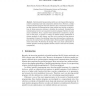Free Online Productivity Tools
i2Speak
i2Symbol
i2OCR
iTex2Img
iWeb2Print
iWeb2Shot
i2Type
iPdf2Split
iPdf2Merge
i2Bopomofo
i2Arabic
i2Style
i2Image
i2PDF
iLatex2Rtf
Sci2ools
EUROPAR
2007
Springer
2007
Springer
Domain-Specific Optimization Strategy for Skeleton Programs
Skeletal parallel programming enables us to develop parallel programs easily by composing ready-made components called skeletons. However, a simplycomposed skeleton program often lacks efficiency due to overheads of intermediate data structures and communications. Many studies have focused on optimizations by fusing successive skeletons to eliminate the overheads. Existing fusion transformations, however, are too general to achieve adequate efficiency for some classes of problems. Thus, a specific fusion optimization is needed for a specific class. In this paper, we propose a strategy for domain-specific optimization of programs. In this strategy, one starts with a normal form that abstracts the programs of interest, then develops fusion rules that transform a skeleton program into the normal form, and finally makes efficient parallel implementation of the normal form. We illustrate the strategy with a case study: optimization of skeleton programs involving neighbor elements, which is ...
Distributed And Parallel Computing | EUROPAR 2007 | Normal Form | Skeletal Parallel Programming | Skeleton Programs |
| Added | 16 Aug 2010 |
| Updated | 16 Aug 2010 |
| Type | Conference |
| Year | 2007 |
| Where | EUROPAR |
| Authors | Kento Emoto, Kiminori Matsuzaki, Zhenjiang Hu, Masato Takeichi |
Comments (0)

